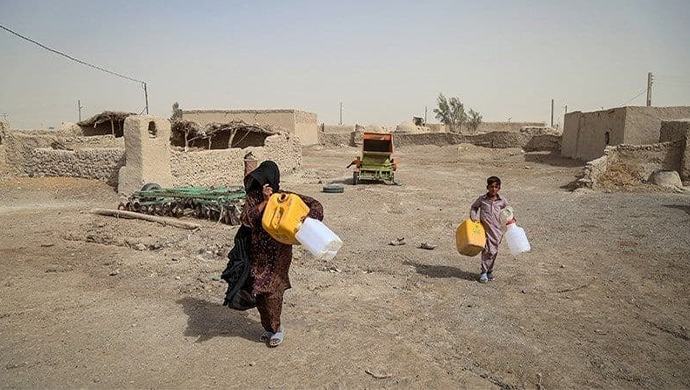In a country with a vast amount of water sources, over 300 cities and thousands of villages across Iran are currently suffering from severe water shortages. In some areas, people don’t have any access to running water other than tankers that arrive periodically to provide the very minimum. The irony is that during the past few weeks, many cities, towns, and villages throughout Iran have also been hit by massive floods. This further proves the unfortunate reality that the mullahs’ regime and its destructive policies are at the roots of Iran’s escalating water crisis.
Reports from the city of Hamedan in western Iran indicate that during the past five days, there has not been a single drop of running water for the locals. The water in the pipes are dirty and not even adequate for washing purposes, let alone for drinking or cooking. The lake behind the local Ekbatan Dam, which provides water for Hamedan, has dried to nothing but a muddy wetland.
Hamedan, western #Iran
Locals say they don't have running water for seven hours each day and when they do, it is not clean at all and has a very strong odor.#43YearsOfMisery pic.twitter.com/7ecYY90KVL— People's Mojahedin Organization of Iran (PMOI/MEK) (@Mojahedineng) August 22, 2022
In such circumstances, the officials of Hamedan province have been resorting to more hollow promises and encouraging the people to tolerate these conditions for the time being. The provincial governor was seen on state TV on August 18, saying the water shortage issue will be resolved “in the coming months.” He also said they will be leasing 12 wells to have their waters processed into the cities piping system.
Even if one would believe this promise, how can 12 wells provide for the city of Hamedan with a population of over half a million people? What about the farmers of Hamedan province that will see their waters outsourced for other purposes? Of course, regime officials in Iran do not feel obligated to answer these questions.
However, what regime officials are concerned about focuses on the high probability of this “water crisis” evolving into a “security crisis,” as described by the regime’s Intelligence Minister during his recent visit to the city of Shahrekord in Chaharmahal & Bakhtiari, where locals have also been suffering from severe water shortages for weeks now.
We will be facing a water crisis in all of Iran
”Issa Kalantari, former head of the regime’s Environment Protection Organization, described the forecasting of some experts about Iran’s water resources depleting in the next 50 years as too optimistic. On August 8, 2018, the state-run “Dideban Iran” website quoted him as saying, “Aside from Khuzestan, we will be facing a water crisis in all of Iran.”
The water crisis of the past four years in Iran indicates that Kalantari’s own forecast was also too optimistic because not only is Khuzestan province suffering from water shortages, it is considered one of the most water-scarce parts of the country. Last year the mullahs’ regime resorted to a bloody crackdown against protests by locals in Khuzestan province who took to the streets, angry over severe water shortages.
Furthermore, Kalantari and several foreign experts had warned that Iran’s water shortages will lead to tens of millions of people leaving their hometowns. Javan daily, a newspaper affiliated with the Revolutionary Guards (IRGC), published a piece on Monday, August 22, indicating this trend has already begun.
“In areas such as Isfahan, the local population has started to evacuate… the country’s environment and water resources must be taken out of the control of the water mafia, which is part of the economic mafia,” the piece adds. This is quite hypocritical considering the fact that that the IRGC itself already has established near-full control over the country’s water sources, depleting huge amounts of water for its industrial initiatives, including steel production companies, petrochemical sites, and not to mention, the regime’s weapons manufacturing industries.
What is certain is the fact that this regime and its policies will day by day, year by year, only destroy the country in its entirety. Although the destruction of Iran’s environment has continued as a result of the mullahs’ rule, the severe water shortage crisis and grim future is by far the most dangerous of these dilemmas. The regime’s uncontrolled dam construction aiming to fill the pockets of the corrupt IRGC, alongside unbridled extraction from underground water sources and worn out and untended water infrastructure of cities and towns, have resulted in strategic setbacks for Iran’s water sources. This has severely damaged the country’s lakes and wetlands and resulted in land subsidence across the country, including even in the capital Tehran.
Locals are describing these phenomena as “Land Death” and a “silent earthquake” in the making. Iran’s natural infrastructure is literally being destroyed and experts are predicting Iran will be uninhabitable in 50 years.
If there is a popular government in Iran, the water crisis will undoubtedly be resolved, and the first and most accessible way is to invest in the proper management of the agriculture sector.
Mechanizing Iran’s agriculture with a drip irrigation system and the pressurized system will save a lot of water.
For example, in Persian Gulf countries, there is not even a seasonal river or a lake. The water of cities such as Dubai, which is located in a desert much drier than the deserts of Iran, is supplied by the Persian Gulf.
Therefore, it is possible to invest in the water sector and save the land of Iran from extinction and destruction.
But the regime’s priorities are acquiring atomic bombs, exporting terrorism and fundamentalism, developing ballistic missiles, and suppressing protesters and dissidents.
There are thousands of villages that are currently supplied with drinking water by tankers, and millions of Iranians are forced to leave their cities and villages and go to the slums or large cities due to lack of water, and the regime has done nothing for them.





